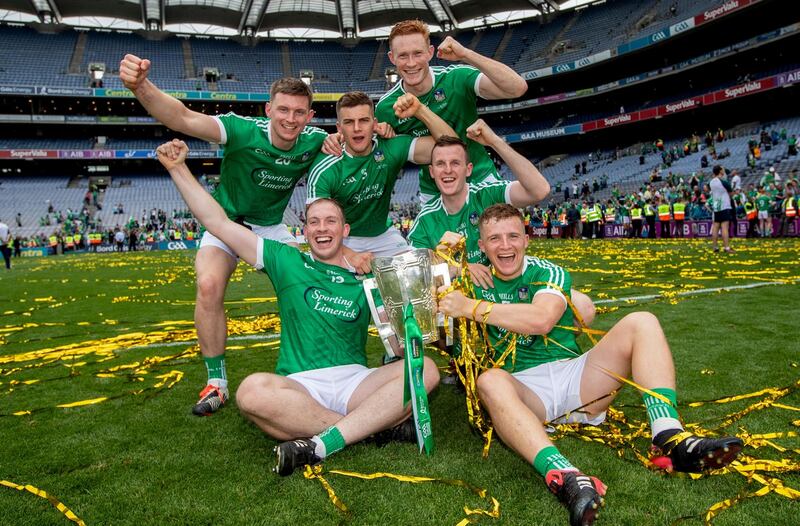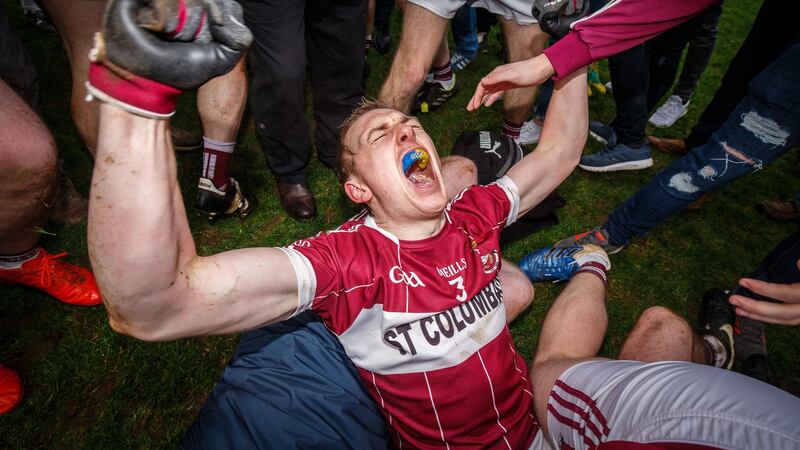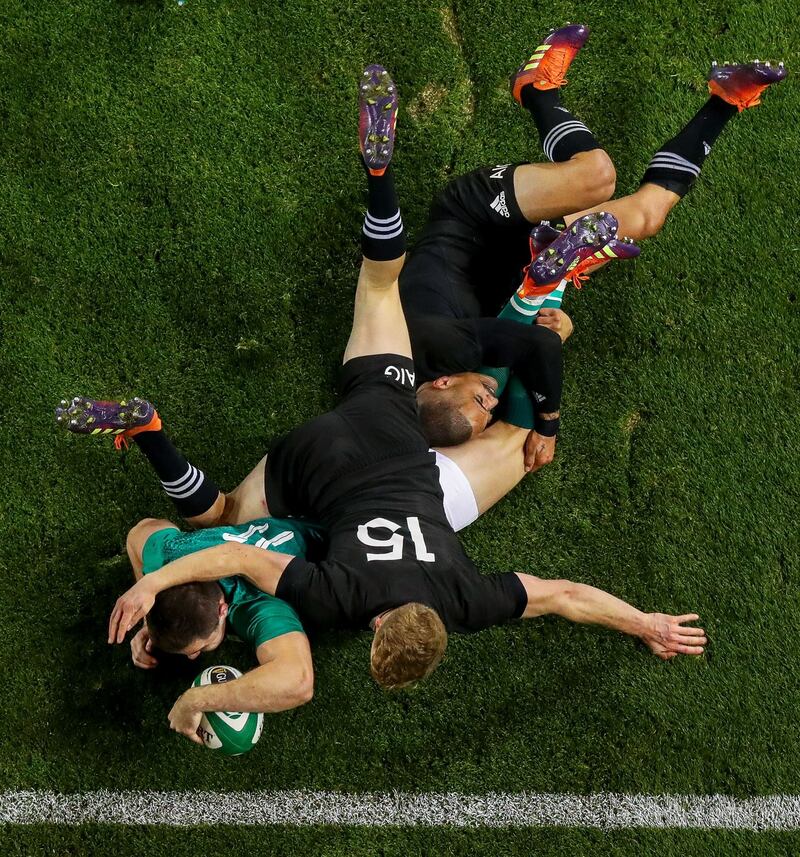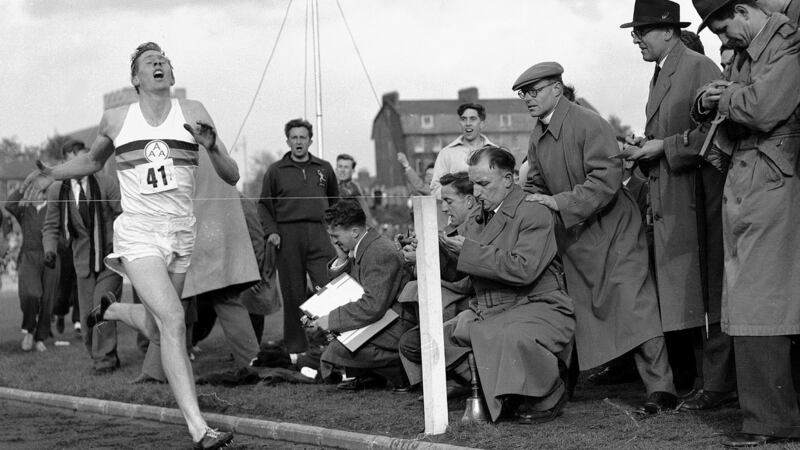Thursday morning now and you are in the fog of deepest Christmas. December 27th. The country is sherry soused and over-fed and having spent 72 hours indoors in one another’s company, the beloved families of Ireland are on the verge of turning mutinous.
Hard borders are popping up all over the gaff. Those who slaved over hot stoves are beginning to mutter darkly that’s it’s an awful lot of fuss. For. One. Day. And it is. But you have to remind yourself that much like GAA Congress or a congratulatory statement by Minister Shane Ross, Christmas is both a state of mind and a test of endurance. It’s all about pacing yourself and slogging through. You’ve hit that valley between the post-St Stephen’s Day low and the rev-up to New Year’s Eve. But you’ve got stamina. You’ve got game.
It’s early morning. Old Man Christmas, the bearer of gifts, has been and gone, in and out of town like a junior minister on the election trail. Right now, the living-room is a cross between Smyth’s toy store and Francis Bacon’s studio. The big guy has left behind him, in addition to a frightening credit card bill, a devastation of wrapping, unwanted colognes, a tangle of phone and console chargers, even more Lego and, in the corner, a cute, furry, bespectacled little gizmo of uncertain provenance who you suspect may be demonically possessed.

In his expression of profound disillusionment, he bears a disconcerting resemblance to Joe Brolly after a particularly harrowing Ulster championship match. In your haze, you come up with a brainwave for next year’s Christmas market: a line of Spillane-Brolly gremlin toy characters who deliver their gems –“Twas a poor game, Michael”, “What about the kids at home watching this?” – whenever you press a button. Or luxury versions that stay silent when you do.
But these are suspicious times. They've already begun to ask the hard questions... where are the Clauses going to live once the North Pole is finished melting; will Santa have to go through customs to get into Fermanagh after Brexit
On Christmas Eve, maybe you’d watched the children in the house, maybe your own, or the nephews or younger siblings, Google-tracking the lightning progression of Santa Claus’s round-the-world trip. Perhaps your little one believes, with all his heart, with all her might.
But these are suspicious times. You can see the scepticism in her eyes; the doubt on his face. They’ve already begun to ask the hard questions. They’re demanding to know, for instance, where the Clauses are going to live once the North Pole is finished melting. They want to know if he’ll have to go through customs to get into Fermanagh after Brexit. They also know the big guy is, like, 200 years old while Blitzen and company have put in many thousands of what Donal Lenihan would term as “the hard yards.”
Yet Claus and the pack are faster than ever. It’s hard to square that. And you don’t want to admit it but in recent representations, old Claus has shed the cuddly, Dad-bod look of yesteryear. If anything, underneath the famous red suit, the dude looks almost . . . ripped. Together you watch that famous sleigh lighting up the households of Moscow – or at least the households that Vlad Putin okay-ed – in a time of 14 seconds flat. You hear your child ask the question that permeates the world of sport more than ever. How is this possible? Is this really real?
Depends what you mean by real, you reply.
See, maybe your boy or girl or niece or nephew is trying to figure it out, what “sport” is supposed to be in this information and data age. And as Pee Flynn once told the nation: it ain’t easy. They’re attempting to sift through the deluge of noise and imagery and marketing and hype and numbers to try and figure out what’s real and who should be cherished and who is faking it. In Ireland – a claustrophobically small damp island in which sport is a kind of language – that task is made a little bit easier. In Ireland, the good in sport still far outweighs the bad.

Grousing about the GAA, for instance, is a national pastime and long may that continue. But deep down, everyone knows it – the GAA is a miracle. What happened in places like Gaoth Dobhair and Mullinalaghta during this soaked autumn/winter was special: their season-of-seasons have rendered their long nights incandescent and unforgettable.
The video essays posted on social media by Neil McGee and Kevin Cassidy chronicled what Gaelic games are supposed to be about: insatiable commitment on the field and ineradicable memories off it. In the summer, Limerick hurling came rocketing through the disappointments since 1973 and for once, a Galway hurling team managed to lose a final and win further admirers.
Dublin’s masterful completion of four All-Ireland football titles in a row deepened both admiration and the shrieks of panic – the game is doomed. Is the championship structure slanted to favour the counties with the most people? Yes, same as it has been for 125 years. Is this Dublin team special? Indisputably. Has their golden period coincided with a dip in the quality of the other empire counties? Unquestionably.
Gaelic football is the big beast of Irish sport. It will be fine, always. Hurling’s recent addition to the Unesco world heritage landmarks offers both further fuel to the purists who think they should just saint the game and be done with it and the realists who understand that its mere survival will take careful cultivation and guardianship. But overall, Gaelic games are thriving.

One of the happy mysteries of Irish sport concerns the inexorable rise of the professional rugby scene to the point where, at the very least, the aristocrats are thinking twice about them. There’s every possibility, of course, that if New Zealand and Ireland do meet in next year’s World Cup in Japan, the All Blacks will inflict painful retribution for the November night in Dublin when only Jacob Stockdale crossed the try-line and Ireland recorded a first-ever win on home soil.
If that happens, the revisionism will be inevitable – and wrong. What happens next year will be distinct and all but unrelated. 2018 was a perfect season for Irish rugby: Leinster as European champions, a Grand Slam for Ireland and that dauntless night against the All Blacks. The sport here can ask no more of itself.
It placed an uncomfortable spotlight on the negative side of rugby culture – the machismo, the sweeping sense of entitlement, the braggadocio and, in this case, the rampant misogyny
But it’s impossible, of course, to forget that Ireland’s magical rugby season was played out against the long trial in Belfast when two Irish internationals, Paddy Jackson and Stuart Olding, stood accused of raping a young woman at a house party. It was a strange and strained two months in which the public profile of the defendants elevated the media coverage of the trial to international dimensions.
As details of the trial were relayed and cross-examined in court, it placed an uncomfortable spotlight on the negative side of rugby culture – the machismo, the sweeping sense of entitlement, the braggadocio and, in this case, the rampant misogyny: the appalling disrespect.
It’s hard to imagine that any individual displayed greater moral courage or dignity than the young woman at the centre of the case. The not-guilty verdicts did nothing to lessen the bad taste and generated a wave of public protest and vividly expressed antipathy on both sides of the Border. Two weeks after the verdicts, the IRFU and Ulster rugby released terse statements to the effect that they had revoked the contracts of both men. The explanation was vague, citing commitment to the “core values of the game”.
That was the bleak backdrop against which an Irish rugby team won the Grand Slam with a 24-15 win in Twickenham. Nothing did more to illuminate the truth that professional sport is, ultimately, showbiz: that behind the set-plays and brilliance, the noise and advertising and media are real people and real lives and real failings.
The rugby year ended, after all, with Brian O’Driscoll, Ireland’s virtuoso, casually recalling that he used to knock back painkillers like M&Ms in the later years of his career. It wasn’t how we liked to remember the number 13, who moved with ghostly beauty when carrying the ball and tackled with vengeful intent when he wanted it back. Popping painkillers did not fit with the language used to describe these sports men. Warriors. Heroes. Gladiators. Legends aren’t supposed to need Difene.
But there you had it: another small, significant glimpse into the truth that behind the swift hands and the thrilling collisions, there’s a brutality at the heart of rugby.
And yet on Saturday mornings, the rugby fields are crowded with nine and 10-year old children in oversized shirts and proud parents on the sideline. More than ever, rugby is appealing and aspirational. You can see how any boy or girl could easily imagine themselves “being” like Johnny Sexton: that’s the old-fashioned sporting daydream.
Still, the coverage of sport has become so screen-oriented and is so available that it’s complicated for all of us to appreciate it all. And it’s even more complicated if you are, in 2018, a girl who is fascinated by sport. It’s even harder for her to find her role models. If she likes Gaelic football, then, yes, the spectacle and glamour of All-Ireland final between Dublin and Cork would have made that world worth chasing.
But what about the rest of the year? What about everywhere else? One of the most popular shows on Netflix is The Simone Biles, a real-life glimpse into the extraordinary rise of America's peerless Olympian gymnast. As recently as November, Biles won six gold medals at the world championships. It was all there; the dervish twists, the unfathomable dynamism in a 4'8" frame and the sequins and glitz that make gymnastics such an appealing spectacle for young girls.
The breadth and scale of Nassar's violations were so numerous and brazen that they almost defied explanation
However, Biles’s enduring triumphs stand as the ultimate response to the shattered reputation of US gymnastics. The year began when a parade of gymnasts, including Biles and other multi Olympic winning medallists, stood in a Michigan court room to deliver statements at the trial of Larry Nassar, the former national team doctor who pleaded guilty to the worst cases of sexual abuse perpetrated in sport.
The breadth and scale of Nassar’s violations were so numerous and brazen that they almost defied explanation. It was left to the athletes he abused, now young women, to provide the words. And they did. Among the many powerful testimonies, the sustained and unflinching address by Aly Raisman, who initially felt she couldn’t face Nassar in court, stood out as both a magisterial refusal to be defined or broken by his actions and also a fearless indictment of the culture and attitudes that facilitated the abuse.
Throughout the year, Raisman has acted as US gymnastics public conscience, calling the governing body out on its every misstep and leaden statement. She is still just 24 and one of the most decorated athletes in her sport. Like the others, she gave countless hours to chase the best of it and the custodians of the sport, not the sport itself, failed her and hundreds of other athletes under its care in a way that was life-changing. If and when those survivors appear at the Toyko Olympics, it will be a moment.

A strange year in benighted, cleaved England. In March, Roger Bannister, one of the enduring symbols not just of sport in the 20th century but of a definitively English sensibility, died at the age of 88. Tributes universally agreed that he was the last word in class and decorum. Getting a handle on the significance of his sporting legacy was trickier.
Running the four-minute mile is no longer a formidable feat. But Bannister broke that barrier. On the pleasant evening at the Ifley track in Oxford on May 6th, 1954, the wind conditions favourable and the Trilby hats everywhere, Bannister, in front of 3,000 spectators, grasped the unattainable.
It helped that a camera was there to record the entire race in gorgeously clean black and white. It helped, too, that there was a poetic ring about the time of 3.59.4. Bannister’s record lasted just six weeks, when John Landy shaved a full second off it and Bannister himself disappeared into medicine before the year was out. Still, his feat travelled through the decades and the arresting image of the gaunt, exhausted Englishman at the finish line was celebrated again this year as an emblem of uncomplicated, enduring valour.
It was a sports event that needed no embellishment or hype or salesmanship to prove its worth. And there was plenty of that quality in evidence that year, plenty of authenticity. 2018 was the summer the England football team, guided by the waist-coated and persuasive Gareth Southgate, threatened to win the World Cup and admirers at the same time.
It was the summer when the Ireland women’s hockey team defied all reasonable ambitions and dragged their sport centre stage as they made it to the dreamland of the World Cup final against the Netherlands. Hockey is one of the many sports in Ireland existing in the shadows of the big three.
It was one of those rare instances when a team somehow captures a national audience by force of charisma and exhilarating performances which briefly transformed Ireland into a hockey country for one weekend. Their homecoming on Dame Street would have been unimaginable to the team when they departed for the tournament. In the news bulletins, delighted supporters said the same thing. They spoke about recognition. About hopes for funding. One woman said she’d been playing hockey for 30 years and was delighted just to see it “on the map”.
That’s the struggle which most people involved in sport would recognise. You persevere, just because. “And my mind took over. It raced ahead of my body and drove me compellingly forward,” Roger Bannister would say of the last lap of his immortal race. “I felt like the moment of a lifetime had come.”
It’s what they’re all chasing and it is, through the noise, our privilege to witness. Happy Christmas.


















